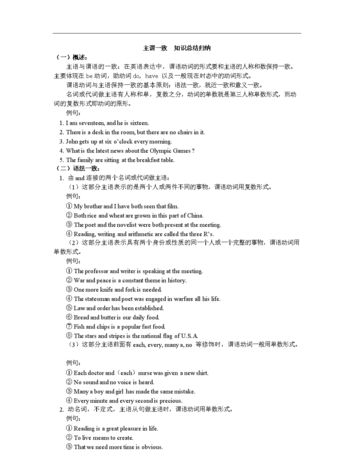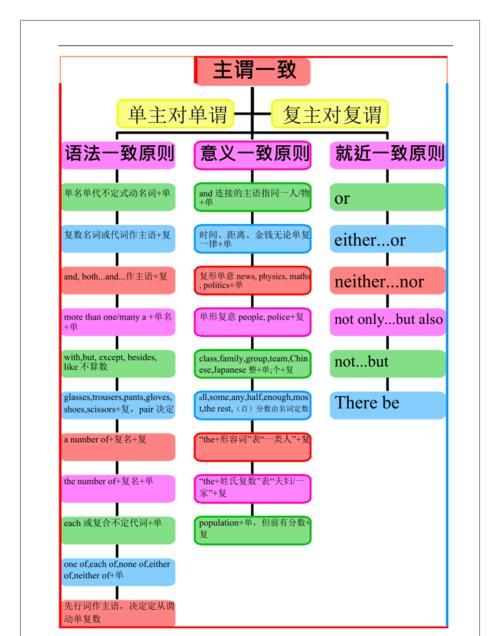本文目录
and主谓一致的用法
在英语句子里,谓语受主语支配,其动词必须和主语在人称和数上保持一致,这就叫主谓一致。寻其规律,大致可归纳为三个原则,即语法一致、逻辑意义一致和就近一致原则。
一、就近一致原则
在英语句子中,有时谓语动词的人称和数与最近的主语保持一致。
1. 当两个主语由either …… or, neither …… nor, whether …… or ……, not only …… but also连接时,谓语动词和邻近的主语一致。如:Either the teacher or the students are our friends. / Neither they nor he is wholly right. / Is neither he nor they wholly right?
2. there be句型be动词单复数取决于其后的主语。如果其后是由and连接的两个主语,则应与靠近的那个主语保持一致。如:There are two chairs and a desk in the room.
注意:Here引导的句子用法同上。
二、语法一致原则
语法上一致就是谓语动词和主语在单、复数形式上保持一致。
1. 以单数名词或代词、动词不定式短语、动名词短语或从句作主语时,谓语动词一般用单数形式;主语为复数时,谓语动词用复数形式。如:His father is working on the farm. / To study English well is not easy. / What he said is very important for us all. / The children were in the classroom two hours ago. / Reading in the sun is bad for your eyes.
注意:由what引导的主语从句,后面的谓语动词多数情况用单数形式,但若表语是复数或what从句是一个带有复数意义的并列结构时,主句的谓语动词用复数形式。如:What I bought were three English books. / What I say and do is (are) helpful to you.
2. 由连接词and或both …… and连接起来的合成主语后面,要用复数形式的谓语动词。如:Lucy and Lily are twins. / She and I are classmates. / The boy and the girl were surprised when they heard the news. / Both she and he are Young Pioneers.
注意:(1)若and所连接的两个词是指同一个人或物时,它后面的谓语动词就应用单数形式。如:The writer and artist has come. (2)由and连接的并列单数主语前如果分别有no, each, every more than a (an) , many a (an)修饰时,其谓语动词要用单数形式。如:Every student and every teacher was in the room. / No boy and no girl likes it.
3. 主语为单数名词或代词,尽管后面跟有with, together with, except, but, like, as well as, rather than, more than, no less than, besides, including等引起的短语,谓语动词仍用单数形式;若主语为复数,谓语用复数形式。如:Mr. Green, together with his wife and children, has come to China. / Nobody but Jim and Mike was on the playground. / She, like you and Tom, is very tall.
4. either, neither, each, every 或no +单数名词和由some, any, no, every构成的复合不定代词,都作单数看待。如:Each of us has a new book. / Everything around us is matter.
注意:(1)在口语中当either或neither后跟有“of+复数名词(或代词)”作主语时,其谓语动词也可用复数。如:Neither of the texts is (are) interesting. (2)若none of后面的名词是不可数名词,它的谓语动词就要用单数;若它后面的名词是复数,它的谓语动词用单数或复数都可以。如:None of us has (have) been to America.
5. 在定语从句时,关系代词that, who, which等作主语时,其谓语动词的数应与句中先行词的数一致。如:He is one of my friends who are working hard. / He is the only one of my friends who is working hard.
6. 如果集体名词指的是整个集体,它的谓语动词用单数;如果它指集体的成员,其谓语动词就用复数形式。这些词有family, class, crowd, committee, population, audience等。如:Class Four is on the third floor. / Class Four are unable to agree upon a monitor.
注意:people, police, cattle等名词一般都用作复数。如:The police are looking for the lost child.
7. 由“a lot of, lots of, plenty of, the rest of, the majority of + 名词”构成的短语以及由“分数或百分数+名词”构成的短语作主语,其谓语动词的数要根据短语中后面名词的数而定。如:There are a lot of people in the classroom. / The rest of the lecture is wonderful. / 50% of the students in our class are girls.
注意:a number of“许多”,作定语修饰复数名词,谓语用复数;the number of“……的数量”,主语是number,谓语用单数。
8. 在倒装句中,谓语动词的数应与其后的主语一致。如:There comes the bus. / On the wall are many pictures. / Such is the result. / Such are the facts.
三、逻辑意义一致原则
逻辑意义一致就是谓语动词的数必须和主语的意义一致(因有时主语形式为单数,但意义为复数;有时形式为复数,但意义为单数)。
1. what, who, which, any, more, all等代词可以是单数,也可是复数,主要靠意思来决定。如:Which is your bag? / Which are your bags? / All is going well. / All have gone to Beijing.
2. 表示“时间、重量、长度、价值”等的名词的复数作主语时,谓语动词通常用单数形式,这是由于作主语的名词在概念上是一个整体,如:Thirty minutes is enough for the work.
3. 若英语是书名、片名、格言、剧名、报名、国名等的复数形式,其谓语动词通常用单数形式。如:“The Arabian Nights” is an interesting story-book.
4. 表数量的短语“one and a half”后接复数名词作主语时,其谓语动词可用单数形式(也可用复数。如:One and a half apples is (are) left on the table.
5. 算式中表示数目(字)的主语通常作单数看待,其谓语动词采用单数形式。如:Twelve plus eight is twenty. / Fifty-six divided by eight is seven.
6. 一些学科名词是以 –ics 结尾,如:mathematics, politics, physics 以及news, works等,都属于形式上是复数的名词,实际意义为单数名词,它们作主语时,其谓语动词要用单数形式。如:The paper works was built in 1990. / I think physics isn‘t easy to study.
7. trousers, glasses, clothes, shoes, 等词作主语时,谓语用复数,但如果这些名词前有a (the) pair of等量词修饰时,谓语动词用单数。如:My glasses are broken. / The pair of shoes under the bed is his.
8. “定冠词the + 形容词或分词”,表示某一类人时,动词用复数。

amount和quantity主谓一致的用法
一、主谓一致三原则
主谓一致是指谓语动词与主语在人称和数上保持一致,主谓一致必须遵循三原则:语法一致原则,意义一致原则,就近一致原则。
1.
语法一致原则:指主语是单数形式,谓语动词用单数形式,主语是复数形式,谓语也用复数形式。例如:
Tom
is
a
good
student.
汤姆是个好学生。
They
often
play
football
on
the
playground.
他们经常在操场上踢足球。
2.
意义一致:指主语形式上为单数,但意义为复数,因此谓语动词用复数形式;或主语形式上为复数,但表示单数意义,这是谓语动词用单数形式。例如:
My
family
are
having
lunch
now.
我们一家人现在正吃午饭。
Twenty
dollars
is
too
expensive
for
the
book.
这本书20美元太贵了。
3.
就近一致:指谓语动词用单数形式还是用复数形式,取决于最靠近他的主语。例如:
Not
only
the
teacher
but
also
his
students
like
playing
football.
不仅老师喜欢踢足球,而且他的学生也喜欢踢足球。
There
is
a
pen
and
some
books
on
the
desk.
课桌上有一支钢笔和一些书。

主谓一致要注意什么
用作主语的名词词组中心词和谓语动词在单、复数形式上的一致,就是语法一致.也就是说,如果名词中心词是单数,动词用单数形式;如果名词中心词是复数,动词用复数形式.例如:
This table is a genuine antique.
Both parties have their own advantages.
Her job has something to do with computers.
She wants to go home.
They are divorcing each other.
Mary was watching herself in the mirror.
The bird built a nest.
Susan comes home every week-end.
(二) 编辑本段 回目录 主谓一致 - 意义一致原则
有时,主语和谓语动词的一致关系取决于主语的单、复数意义,而不是语法上的单、复数形式,这样的一致关系就是意义一致.例如:
Democratic government gradually take the place of an all-powerful monarchy.
A barracks was attacked by the guerilla.
Mumps is a kind of infectious disease.
The United States is a developed country.
It is the remains of a ruined palace.
The archives was lost.
This pair of trousers costs fifty dollars.
(三) 编辑本段 回目录 主谓一致 - 就近原则
有时,谓语动词的单、复数形式决定于最靠近它的词语.
例如:
Either my grandsons or their father is coming.
No one except his daughters agree with him.
Mary and her sisters are baking a cake.
Neither Richard nor I am going.
编辑本段 回目录 主谓一致 - 以集合名词做主语的主谓一致问题
有些集合名词,ommittee,council,crew,crowd,family,gang,government,group,mob,staff,team, union等,在意义上是复数,但在语法形式上是单数,这类名词作主语的主谓一致问题往往遵循“语法一致”或“意义一致”原则.例如:
The committee has/have decided to dismiss him.
A council of elders governs the tribe.
The present government is trying to control inflation.
The school staff are expected to supervise school meals.
(一)通常作复数的集体名词
包括police,people, cattle, militia, vermin等,这些集体名词通常用作复数.
例如:
The British police have only very limited powers.
The militia were called out to guard the borderland.
It seems the cattle on the sides of the dikes were the only living creatures in these desolate surroundings.
(二)通常作不可数名词的集体名词
通常作不可数名词的集体名词,包括poultry,foliage,machinery, equipment,furniture,
merchandise等,这类名词后的动词用单数形式.
例如:
Poultry is expensive at this time of year.
That green foliage was restful.
The merchandise has arrived undamaged.
All the machinery in the factory is made in China.
The suite of furniture he bought was of contemporary style.
The equipment of the photographic studio was expensive.
(三)可作单数也可作复数的集体名词
可作单数也可作复数的集体名词,包括audience, committee, crew, family, government,jury等.
例如:
The audience was/were enthusiastic on the opening night of the play.
The committee has/have decided to dismiss him.
The jury is/are about to announce the winners.
The government has/have discussed the matter for a long time.
三、a committee, etc of +复数名词的主谓一致问题
如果主语是由a committee of /a panel of /a (the) board of +复数名词构成,随后的动词通常用单数.
例如:
A committee of twelve men is to discuss the matter.
A panel of experts has considered the situation.
The board of managers is responsible for the firm.
四、以-s结尾的名词作主语的主谓一致问题
英语可数名词的规则复数形式是在词尾加-s或-es,但是有一些以-s结尾的名词并不是可数名词.它们用法多样,造成了实际使用上的困难,以下详述了以-s结尾的名词作主语的主谓一致问题.
(一)以-s结尾的疾病名称作主语的主谓一致问题
(二)以-s结尾的游戏名称作主语的主谓一致问题
(三)以-s结尾的地理名称作主语的主谓一致问题
(四)以-ics结尾的学科名称作主语的主谓一致问题
(五)其它以-s结尾的名词的主谓一致问题
(一)以-s结尾的疾病名称作主语的主谓一致问题
以-s结尾的疾病名称作主语的主谓一致问题,如:arthritis,bronchitis,diabetes,mumps,phlebitis,rickets,这类以-s结尾的疾病名称作主语时,谓语动词通常用作单数.
例如:
Arthritis causes great pain in the joints of the patient.
The diabetes is a kind of chronic disease.
Measles usually occurs in children.
Phlebitis is a swollen condition of the blood vessels.
(二)以-s结尾的游戏名称作主语的主谓一致问题
以-s结尾的游戏名称作主语时,谓语动词通常用作单数.
例如:
Darts is basically a easy game.
Marbles is not confined to children.
Skittles is not fashionable nowadays.
Draughts is not very difficult to learn.
但当Darts,Marbles等的意义为游戏器具而非游戏名称时,谓语动词通常用作复数.
例如:
Three darts are thrown at each turn.
All nine skittles were brought down by the good throw.
(三)以-s结尾的地理名称作主语的主谓一致问题
某些以-s结尾的地理名称,如果是国名,如the United States,the Netherlands等,因其是单一政治实体,所以谓语动词用作单数.
例如:
The United States was hit by the Great Depression in 1930s'.
In early January 1996 the Netherlands was hit by its worst storm since 1976.
但如果是群岛、山脉、海峡、瀑布等地理名称作主语,谓语动词用作复数.
例如:
The West Indies are commonly divided into two parts.
The Himalayas have a magnificent variety of plant.
The Straits of Gibraltar have not lost their strategic importance.
The Niagara Falls are perhaps the most splendid waterfall in the world.
(四)以-ics结尾的学科名称作主语的主谓一致问题
某些以-ics结尾的学科名称作主语时,如physics,mathematics,mechanics, optics, acoustics, politics statistics, economics, linguistics, athletics等, 谓语动词通常用作单数.
例如:
Physics is a fundamental subject in science.
The third world economics is promising.
Acoustics studies the science of sound.
Mathematics is an interesting subject.
Athletics is a required course for students of all grades.
但如果这类名词表示学科以外的其它含义,可作复数用.
例如:
Athletics have been greatly encouraged at this college.
The acoustics of the new concert hall are perfect.
The economics of the project are still at issue.
(五)其它以-s结尾的名词的主谓一致问题
A.以-s结尾的由两部分组成的物体名称作主语
英语中有一些通常以-s结尾的由两部分组成的物体名词,如glasses, pincers,pliers,scissors, shorts,suspenders,trousers等,这类名词做主语,如果不带“一把”、“一副”等单位词,谓语动词通常用复数.
例如:
Mary's glasses are new.
John's trousers are black.
如果带有单位词, 则由单位词决定动词的单、复数形式.
例如:
One pair of pincers isn't enough.
Two pairs of scissors are missing from my tool box.
B.其他以-s结尾的名词
英语中还有一些以- s结尾的名词,如archives,arms,clothes, contents, eaves, fireworks, goods, minutes, morals, remains stairs, suburbs, thanks,wages这类名词作主语时,谓语动词通常用复数.
例如:
The archives of the country are kept in the Department of Security.
The contents of the book are most amusing.
High wages often result in high prices.
My thanks are sincere.
五、如果句子的主语是并列结构,其主谓一致问题通常遵循以下原则:
(一)由and/both...and连接的并列主语的主谓一致问题
(二)由or/nor/either...or连接的并列主语的主谓一致问题
(三)主语 + as much as,etc的主谓一致问题
(一)由and/both...and连接的并列主语的主谓一致问题
由and/both...and连接的并列结构作主语,可根据主语的意义决定谓语动词的单、复数形式.
例如:
Pancakes and syrup is a tasty breakfast.
The number and diversity of British newspaper is considerable.
Good and bad taste are inculcated by example.
Fish and chips are getting very expensive.
A truck and a car were in the ditch.
Both Cathy and her daughter Lida have gone fishing in Canada.
当and连接的并列名词词组带有each,every,或者many a 等限定词时,谓语动词通常用单数.
例如:
Each man and each woman there is asked to help.
Every flower and every bush is to be cut down.
Every change of season, every change of weather, indeed every hour of the day, produces some change in the magical hues and shapes of these mountains.
Many a boy was disappointed after seeing the film.
(二)由or/nor/either...or连接的并列主语的主谓一致问题
由or,nor,either...or, neither...nor,not only...but also连接的并列结构作主语,随后的动词形式通常按照“就近原则”处理.
例如:
Neither Lucy nor Carol has any money left.
Neither sleet nor snow stops him from driving his new Mercedes-Benz.
Either Tina or Carol is sure to know the answer.
Neither my father nor my brothers are likely to be at theater.
Neither the Kansas coach nor the players were confident of victory.
Not only one, but all of us are hoping to be there.
Not only the switches but also the old wiring has been stolen.
(三)主语 + as much as,etc的主谓一致问题
当主语后面跟有由as much as, rather than , more than, no less than 等引导的从属结构,或跟有由as well as, in addition to ,with, along with, together with, except等引导的词组时, 其后的动词形式取决主语的形式.
例如:
The vessel, with its entire crew and cargo was lost.
The ocean, as well as the gulf and the bay, provides good fishing.
John, rather than his roommates, is to blame.
Hugh,as well as his two sisters, is vacationing in Wyoming this summer.
Some of the employees as much as the manager were responsible for the failure.
My husband,more than anyone else in the family, is longing to go there again.
Billy, together with his sisters, was wounded in the accident.
No one except two girls was late for school.
六、以表示数量概念的名词词组作主语的主谓一致问题
数量概念分两类:一类是确定数量,如 two years, five seconds,three kilos,等,另一类是非确定数量,如all of..., some of..., none of.如果用这类表示数量概念的名词词组作主语,会产生主谓一致问题.
(一)以表示确定数量的名词词组作主语的主谓一致问题
(二)以表示非确定数量的名词词组作主语的主谓一致问题
(一)以表示确定数量的名词词组作主语
当主语为表示确定数量的名词词组时,如果数量概念被看做一个整体,动词用单数,如果被看做组成该数量的个体,动词用复数.
例如:
The treasurer considered that twenty dollars was not too much to ask.
"Two months is too short a time," General manager warned, "we must hurry up."
Three weeks is needed to complete the task.
There were six silver dollars in each of the stockings.
Three pints is not enough to get him drunk.
A total of 50,000 new bicycles was registered in the year.
如果作主语的名词词组是由“分数/百分数+ of”词组构成,其动词形式 取决于of词组中名词的类别.
例如:
Two-thirds of the people present is against the plan.
Three-fourths of the surface of the earth is covered by sea.
Over twenty percent of the city was destroyed in the war.
Forty-five percent of the doctors were woman.
两数相减或相除,谓语动词用单数;两数相加或相乘,谓语动词可用单数,也可用复数.
例如:
Sixty minus seventeen leaves forty-three.
Forty-two divided by six is seven.
Six and eight makes/make fourteen.
Six times eight is/are forty-eight.
如果主语由"one in/one out of + 复数名词" 构成,在正式语体中,动词用单数.
例如:
One in ten students has passed the examination.
One out of twelve bottles was left intact.
(二)以表示非确定数量的名词词组作主语的主谓一致问题
如果主语由 "a portion of, a series of, a pile of, a panel of +名词"或由“a kind/sort/type of, this kind/sort/type of+名词” 构成,谓语动词通常用单数.
例如:
A panel of us has decided to hire a boat and travel through Holland by canal.
A pile of apple logs was set beside the hearth.
A portion of reports is deceiving.
This kind of cars is rather expensive.
This type of women is dangerous.
That type of machines is up-to-date.
如果主语是由“many a +名词" 或“more than one +名词"构成,随后的动词遵循“语法一致”原则,用单数.
例如:
Many a person in these circumstances has hoped for a long break.
Many a man has his own responsibility.
More than one student has failed the exam.
More than one ship was lost this year.
如果主语是all of, some of,none of, half of, most of,lots of,loads of ,plenty of,等表示非确定数量的名词词组,谓语动词的单、复数形式根据 of词组中名词类别而定.
例如:
Most of the money was recovered by Deputy Player.
All of the cargo was lost.
Some of the books were badly torn.
None of my friends ever come to see me.
Half of the building was destroied during the war.
Half of the students are eager to leave now.
Lots of people are waiting outside.
Loads of apples have been distributed among the children.
Plenty of water was prepared for irrigation.

主谓一致的就远原则例子
主谓一致”,顾名思义,主语与谓语保持一致,这个“一致”指的是在人称和数的变化上保持一致。
主要出现在选择和完型中,既是考点,也是难点,所以也是我们寒假班学习中强调的重点。
其中,出现频率最高,也是我们在寒假课程中再三强调的就是其中的“就近原则”和“‘顾前不顾后’原则”了。、
“就近原则”即在一些句式中,谓语动词必须与离其较近的主语保持一致,常考句式有:
1.or e.g. He or the twins _are_ going to Paris.(be)
2.either...or... e.g. Either the twins or he _is_ going to Paris.(be)
3.neither...nor... e.g. Neither he nor I _am_ going to Paris.(be)
4.not only...but also...(not...but...) e.g. Not only the twins but also I _am_ going to Paris.(be)
5.There be句型 e.g. There _is__ a book and two pens on the desk.(be)
There _are_ two pens and a book on the desk.(be)
“‘顾前不顾后’原则”即在有些句式中,谓语动词必须与最前面的主语保持一致,而不用考虑后面的(主语),常考的有:
1.with/without e.g. Lucy with her parents _is_ watching TV.(be)
2.together/along with e.g. The students together with the teacher _are_ cleaning the calssroom.(be)
3.as well as e.g. I as well as my parents _am_ going to BeiJing.(be)
其实,这些我们在学习连词、介词的时候就提到过,希望同学们认真总结下,做题的时候一定要把这两个原则分清楚。

以上就是关于怎样用主谓一致编故事 ,and主谓一致的用法的全部内容,以及怎样用主谓一致编故事 的相关内容,希望能够帮到您。
